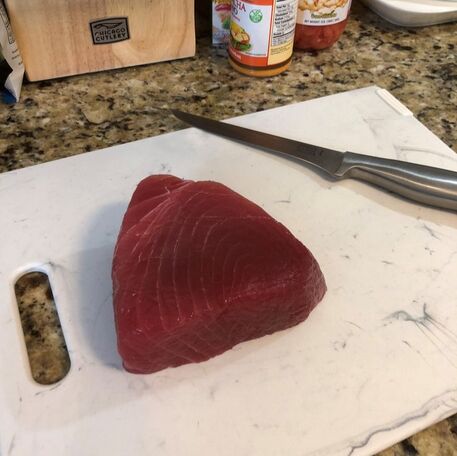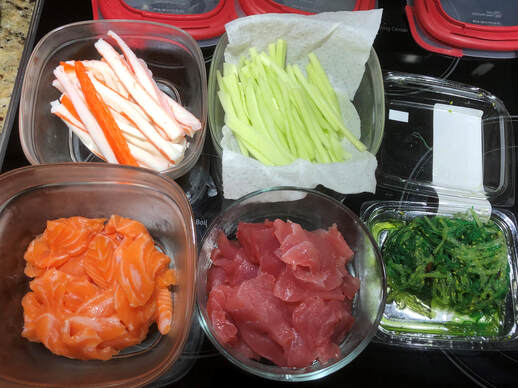|
Ashley and I wish you a happy Thanksgiving. We hope you are enjoying the start of the holiday season. I will be posting an exciting announcement next week along with another homemade sushi article soon.
In the Magic: The Gathering card game, each trading card contains a picture created by an artist. The card artwork is often commissioned by Wizards of the Coast for newly created cards. WOTC hires artists from all over the world to create beautiful scenery, mystical creatures, heroes, and other pieces of fantasy art. The pieces are created with various methods and materials. Some artists also create their work digitally. Artists can keep their original paintings once WOTC is done transforming it into a trading card. These paintings, along with related sketches, are often sold to the public. There are multiple platforms available for purchasing original artwork related to MTG. A quick search on Ebay will display multiple pieces available to purchase. Many artists have a personal website where original artwork is listed for sale. Another website with multiple pieces for sale is the Original Magic Art Store. The most active community centered around buying and selling original MTG related artwork is a public Facebook group called the MTG Art Market. The MTG Art Market contains over 7,000 members. Sketches and original paintings are sold each week. Often, artwork related to new MTG cards is exclusively sold through the group. The three most common types of artwork available to purchase are sketches, color studies, and paintings. Sketches are preliminary drawings of artwork found on MTG cards. Color studies are preliminary paintings to decide on the final color profile and lighting for a painting. Some artists create a color study as a reference for digital creations. Original paintings are the final pieces selected to display on MTG cards. Artwork is sold through the Facebook group as an auction or BIN (Buy It Now) price. Final selling prices vary between sketches, color studies, and paintings. Prices also vary based on the popularity of the card that contains the artwork, the size of the piece, the artist, and other factors. Each artwork has its own unique set of characteristics that can impact a final sale price. While estimating the value of a piece can be difficult, there are general price ranges depending on the type of artwork.
Sketches are the cheapest option to own original MTG artwork. Their prices generally start around $200. It is rare for a sketch to sell for over $800. There may even be multiple sketches of an original painting. Color studies are the next level in pricing between sketches and original paintings. The floor price for a color study is about $400. Prices for color studies can increase to between $1,000 and $2,000. If a physical color study was done for a digital piece, the price is typically higher than average since a painting does not exist. When purchasing original paintings, the lowest starting price is around $1,500. More often, paintings sell between $3,000 and $6,000. On rare occasions, paintings can sell for over $10,000. There are always exceptions to ranges and general rules of thumb. For example, the original painting for Lotus Field from Core 2020 sold for $40,000. In addition, the sketch sold for $1,400. There are multiple reasons why these original pieces sold for a large sum of money. Artwork is fun, beautiful, interesting, and inspiring. However, collecting artwork can become an expensive hobby. When purchasing any piece of MTG artwork, read the full description of the piece before placing a bid. Know when the auction ends and how to place a bid. Pay attention to any additional fees such as shipping, sales tax, and customs. Try to have a maximum bid amount in mind. In addition, avoid letting emotions drive bidding beyond a level of comfort. I am currently enrolled in MBAD 6191 Entrepreneurship at the University of North Carolina Belk School of Business. My class group raised over $1,300 to support the Niner Nation Unites crowdfund. This fund was created to raise money for the victims and their families involved in the UNC Charlotte campus shooting on April 30, 2019. The money was raised by giving away handmade bracelets for any $5.00 or more donation. My group designed and made the bracelets to show our #ninerstrong support. We raised money at UNC Charlotte's alumni tailgate events, the on-campus bookstore, and through personal networks. I am very proud of our accomplishment. Thank you to everyone who donated to our fundraising campaign.
Making sushi at home requires a large amount of preparation work. There are multiple ingredients that require additional steps beyond purchasing them. Fortunately, you will have idle time while the sushi rice cooks in a device and cools to room temperature. I will cover some of the most common preparation steps for creating sushi rolls. Cutting Individual Pieces of Fish When purchasing sashimi grade salmon or tuna, you will likely buy one large fillet at the market. This piece of fish needs to be cut into bite-sized pieces for nigiri, sashimi, and sushi rolls. There are right and wrong approaches to cutting sashimi grade fish. I recommend watching videos on YouTube to learn how to correctly cut fillets with a knife. There are many helpful videos such as this one. In addition, you may want to sharpen your knife prior to starting this process. Cutting and Peeling Vegetables While this may seem obvious, vegetables require preparation. Cucumbers require peeling, deseeding, and slicing into strips. Carrots require peeling and shaving into thin pieces. Avacados should be cut into long, thin strips to fit into rolls. You should try to make individual pieces small for layering in sushi rolls. Other options include jalapenos (deseed), daikon radishes, asparagus, shiitake mushrooms, yams, and picked vegetables. Preparing Cooked Ingredients Some ingredients for sushi rolls require cooking. Examples include seared scallops and tempura fried shrimp. I recommend cooking ingredients while the rice cools to room temperature. You should have around an hour to work on other kitchen preparation prior to making sushi rolls. Setting the Table
One other step that requires preparation is setting the table for a sushi dinner. It can take quite a bit of time to lay out all of the dishes, glasses, and serve ware. This preparation can be done at any time, including prior to making sushi rice. To view the more blog posts in this multi-part series on making sushi at home, click the links below:
|
Follow me
on Instagram @card_knock_life Categories
All
Archives
July 2024
This website contains affiliate links
|








 RSS Feed
RSS Feed
